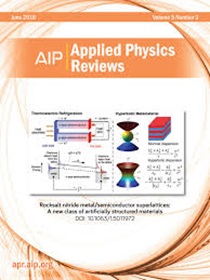用于新一代微光机械器件的新兴无机材料的光致伸缩
IF 11.6
1区 物理与天体物理
Q1 PHYSICS, APPLIED
引用次数: 0
摘要
光致伸缩效应在实现智能微光机械器件方面具有很高的潜力,该器件可以在光能直接转化为机械应变的简单原理下工作。与电致伸缩和磁致伸缩效应不同,它不涉及复杂的电路,因此为实现先进,紧凑和远程控制装置提供了很好的前景。设计高效的光致伸缩材料是产生具有实用价值的光致应变的关键。基于所要探索的用于微光机械器件的材料系统的性质,本文总结了基于无机材料的系统,包括半导体、过渡金属氧化物、卤化物钙钛矿、铁电体和二维的光伸缩。对于每种材料,给出了可行的组合工程策略,加工条件和样品雕刻,特别关注代表性铁电系统中多相边界的细致剪裁,以产生显着的光伸缩。由于铁电光致伸缩被认为是光伏效应和逆压电效应的叠加效应,因此对这两种效应进行了介绍和讨论。最后,对光致伸缩材料的未来研究进行了展望。我们相信这一综述将为生产高效的光致伸缩材料带来新的见解,为即将到来的最先进的微光机械设备的商业化生产提供新的见解。本文章由计算机程序翻译,如有差异,请以英文原文为准。
Photostriction in emerging inorganic materials for next-generation micro-optomechanical devices
Photostrictive effect exhibits a high potential to realize the smart micro-optomechanical devices, which can be operated at a simple principle of direct conversion of light energy into mechanical strain. Unlike electrostrictive and magnetostrictive effects, it does not involve complex circuits, therefore offering a promising prospect of accomplishing the advanced, compact, and remote-control devices. The key step to produce the light-induced strain of practical value is to design highly efficient photostrictive materials. Based upon the nature of the material systems to be explored for micro-optomechanical devices, the photostriction in inorganic–materials-based systems, including semiconductors, transition metal oxides, halide perovskites, and ferroelectrics in bulk and two-dimensions, are summarized herein. For each material, the feasible strategies of compositional engineering, processing conditions, and sample sculpturing, with a special focus on the meticulous tailoring of multiple phase boundaries in representative ferroelectric systems to produce significant photostriction, are given. Since ferroelectric photostriction is accounted as the superposition effect of photovoltaic and inverse piezoelectric effects, both effects are introduced and discussed. Finally, perspectives on future research of photostrictive materials are added. We believe that this review will bring new insights in producing highly efficient photostrictive materials for the commercial production of upcoming state-of-the-art micro optomechanical devices.
求助全文
通过发布文献求助,成功后即可免费获取论文全文。
去求助
来源期刊

Applied physics reviews
PHYSICS, APPLIED-
CiteScore
22.50
自引率
2.00%
发文量
113
审稿时长
2 months
期刊介绍:
Applied Physics Reviews (APR) is a journal featuring articles on critical topics in experimental or theoretical research in applied physics and applications of physics to other scientific and engineering branches. The publication includes two main types of articles:
Original Research: These articles report on high-quality, novel research studies that are of significant interest to the applied physics community.
Reviews: Review articles in APR can either be authoritative and comprehensive assessments of established areas of applied physics or short, timely reviews of recent advances in established fields or emerging areas of applied physics.
 求助内容:
求助内容: 应助结果提醒方式:
应助结果提醒方式:


